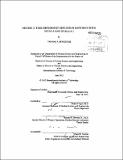MCODE-3 : time-dependent depletion isotopics with MCNP-5 and SCALE-6.1
Author(s)
Gerrity, Thomas P., III
DownloadFull printable version (8.504Mb)
Alternative title
Time-dependent depletion isotopics with MCNP-5 and SCALE-6.1
Other Contributors
Massachusetts Institute of Technology. Dept. of Nuclear Science and Engineering.
Advisor
Benoit Forget.
Terms of use
Metadata
Show full item recordAbstract
In order to operate a reactor safely and efficiently, computer simulations must be used to predict certain nuclear characteristics of the reactor. To determine how materials change in a fission power environment, a time-dependent depletion isotopic code must be used. Over the past several decades, the MIT Reactor (MITR) has taken many steps to prepare for its conversion from the use of highly enriched uranium (HEU) to low enriched uranium (LEU) in its fuel. Throughout this process, detailed neutronics simulations must be run to predict the characteristics of the reactor with its current HEU fuel, with potential forms of LEU fuel, and with combinations of the two. MCODE Version 3 is a linkage code that performs time-dependent burnup calculations by combining the Monte Carlo N-Particle transport code, MCNP, with the Oak Ridge Isotope Generation point depletion code, ORIGEN-S. MCNP provides reaction rates and neutron flux in user-specified irradiation material regions. COUPLE, a data-editing code included in the SCALE- 6.1 software package, uses these data from MCNP to update the cross section libraries, which ORIGEN then uses to perform nuclide depletion calculations in each irradiation zone. The MCNP model is then updated with the depleted material compositions, and the exchange is repeated. The MCNP/ORIGEN coupling utilizes an optional predictor-corrector capability. As a newer version of MCODE Version 2.2, MCODE-3 offers three major changes from its predecessor. The first is the incorporation of ORIGEN-S. MCODE-2 used a previous version of ORIGEN, which is no longer supported by ORNL. ORIGEN-S provides newer nuclear data as well as additional functionality and usability. Secondly, MCODE-3 uses COUPLE to create an entirely unique cross section library from the regionally averaged 238-group flux, which means every cross section value that MCODE-3 uses in its depletion is specific to the input model. MCODE-2 only updates a fraction of nuclides' cross sections, the rest default to a pre-compiled library. Finally, while MCODE-2.2 was written in ANSI C, MCODE-3's main function has been rewritten in the Python scripting language. MCODE's preproc, mcodeout, and mcnpxs programs have not been edited, and are thus still written in ANSI C. Benchmarking has indicated that while the evolution of most nuclides is similar to an MCODE-2 calculation, over many depletion steps some nuclides can diverge due to COUPLE's use of the 238-group flux.
Description
Thesis (S.M. and S.B.)--Massachusetts Institute of Technology, Dept. of Nuclear Science and Engineering, 2012. Cataloged from PDF version of thesis. Includes bibliographical references (p. 45).
Date issued
2012Department
Massachusetts Institute of Technology. Department of Nuclear Science and EngineeringPublisher
Massachusetts Institute of Technology
Keywords
Nuclear Science and Engineering.